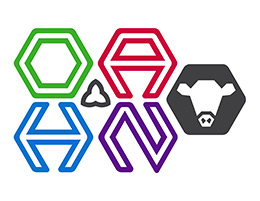Ontario Animal Health Network (OAHN) Bovine Expert Network Quarterly Veterinary Report
Global Surveillance Updates
Asian Longhorned Tick
- The Asian longhorned tick (Haemaphysalis longicornis) is an invasive species that has rapidly expanded its range since its first detection in the United States in 2017. Native to East Asia, this tick has now been found in multiple U.S. states, including New York, Pennsylvania, Ohio and Michigan —regions not far from the Ontario border. Most recently, it was detected in Maine and Kansas. Although it has not yet been detected in Canada, its potential to establish in Ontario is a growing concern among public health and veterinary experts.
- For more information, see OAHN’s new factsheet: Asian Longhorned Tick- An encroaching threat.
New World Screwworm
- As of October 2025, the New World screwworm (NWS) has not been detected in animals or traps within the United States, but recent cases in northern Mexico have increased concern. The USDA has ramped up surveillance efforts along the southern border and expanded sterile fly release programs. Agencies are actively engaging hunters to monitor wildlife for signs of infestation following detections in Nuevo León, Mexico, only 70 miles from Texas. Early detection is considered critical to prevent re-establishment of this devastating parasite in U.S. livestock and wildlife populations.
- Lower climate temperatures are considered protective against establishment in Canada. Veterinarians should consider any history of animal importation when evaluating cases of myiasis. NWS is an immediately notifiable disease in Canada.
Bovine Theileriosis in Ontario
On October 22, the Canadian Food Inspection Agency (CFIA) notified the World Organization of Animal Health (WOAH) of a confirmed case of Theileria oreintalis Ikeda. CFIA was notified on October 8, 2025, of a suspicion of Theileriosis in a cow with regenerative anemia located in Ontario. The cow was imported from the USA on July 15, 2025. The CFIA National Centre for Foreign Animal Disease has confirmed the sample to be positive for Theileria orientalis Ikeda through metagenomic sequencing and genotype identification. This is the first detection of Theileriosis in Canada.
OMAFA has issued a disease advisory with more information on Theileria orientalis Ikeda for veterinarians.
Q2 Bovine Data from the Animal Health Laboratory
A total of 1687 bovine cases were submitted to the AHL during Q2, spanning from May 1 2025 to July 31 2025. Of these, 161 submissions had a pathology component, consisting of 46 postmortem cases and 72 send-in cases. Of these, there were 19 reproductive loss investigations, 28 young calves (under 2 months of age), 48 older calves (2 months to 2 years of age), 23 adult cattle, and 43 meat inspection cases.
Submissions from practitioners included 59 dairy, 52 beef, 2 bison, and 5 cases where the commodity was not specified. Insufficient clinical history was associated with 3 submissions. A total of 92 submissions had a definitive or presumptive diagnosis, and 26 did not have a specific diagnosis (13 abortion work-ups, 2 young calves, 8 older calves, 3 adults).
Pathology Cases of Interest
History: Two pregnant heifers from the same pen were euthanized. A total of 8 animals affected with initial signs of weakness when rising followed by sternal recumbency but bright and eating. Within 2-3 days, cattle progressed to lateral recumbency and died. Botulism strongly suspected.
Pathology: Gross- mild abomasal erosions; Histology- mild pulmonary congestion and edema
Ancillary testing: PCR testing for Botulinum toxins A-F were negative on liver and small intestine, heavy metal screen on liver had no significant findings, and ocular fluid was negative for nitrate and nitrite.
Summary: A definitive cause for the clinical signs and losses in this group was not determined. PCR testing of the liver and the intestinal contents did not detect botulinum toxin, but this is not a perfectly sensitive test, and with the compatible clinical signs and strong clinical suspicion, botulism remained as the top consideration. Typically in cattle, the usual source of the toxin is decaying carcasses incorporated into the feed, and the cause of death is flaccid muscle paralysis resulting in respiratory or cardiac paralysis.
History: Several 8-month-old steers that were banded 1-2 weeks ago and had Tasvax (clostridial vaccine) administered at the time of castration. Multiple have died. Concerned about tetanus.
Histology: Pulmonary congestion and edema with fibrin exudation; mild neutrophilic and lymphoplasmacytic inflammation in tissue from castration site.
Ancillary testing: Anaerobic bacterial culture of the surgical site (scrotum/spermatic cord) isolated 1+ Clostridium tetani, and PCR testing by the bacteriology lab identified tetanus toxin.
Summary: Recent castration in conjunction with bacteriology results and compatible clinical signs is diagnostic for tetanus in this case. Tetanus is generally not associated with histologic lesions, and the pulmonary edema with fibrin exudation identified in this case is a non-specific indicator of increased pulmonary vascular permeability. The mild inflammatory response at the surgical site was compatible with recent castration.
Salmonella
In total, 201 bovine submissions had bacterial culture performed (non-milk), generating 374 cultures. Salmonella spp. were isolated from 8 submissions, representing an estimated 3 premises.
- Salmonella Dublin was isolated from 3 submissions, 1 with no noted record of previous isolation of this pathogen at the premises.
- 2 submissions (2-month-old calves from same premises): Raised as veal calves weaned at 6.5-weeks-old. Calves were vaccinated at 5 weeks (BVD-BRSV-PI3-IBR) and again at 10 weeks (5-way + M.haemoltyica). Diet is a 3:1 corn based veal ration. Calves go backwards, inappetent, emaciated, and die in 2 weeks. No response to macrolides or beta lactams. Histology revealed lesions of septicemia, including fibrinosuppurative and necrotizing pneumonia and necrosuppurative hepatic necrosis, with multi-organ thrombosis. Lung culture isolated 4+ Salmonella Dublin, which was also detected by PCR on lung.
- 1 submission (47 day old calf): Had multiple treatments. Didn’t want to drink milk. Very hard to get up. Very rough looking. Lung culture isolated 4+ Histophilus somni and 2+ Salmonella Dublin. Histopathology was not performed.
- Salmonella Agona (3 submissions) and Salmonella infantis (2 submissions): fecal samples only, no clinical history, all from one submitter
- Salmonella typhimurium (1 submission): fecal sample only
There were 12 bovine submissions that had Salmonella Dublin PCR performed, generating 2 positive samples (2-month-old beef/veal calves).
Bovine Viral Diarrhea Virus (BVDV)
In total, 51 submissions generated 138 samples for BVDV PCR testing, yielding 0 positive samples.
This summary has been compiled by Dr. Rebecca Egan, Animal Health Laboratory (AHL) from diagnostic submissions to the AHL Guelph and Kemptville locations.
Item of interest for bovine practitioners
The CVMA Beef Cattle Medicines Course
Beef cattle producers can use the course to learn the basic principles on how to use animal health products wisely, as part of their on-farm food safety, herd health, and beef sustainability programs.
Mineral Testing 2022-2025
This quarter, the bovine OAHN network reviewed mineral testing data from the Animal Health Lab. Testing was requested for various reasons: in adult cattle (>2 years), mainly reproductive issues and herd monitoring; in calves, monitoring, sudden deaths, weak born calves, and occasional limb deformities. Results likely include animals with and without supplementation, limiting broad risk conclusions. Common deficiency risks in cattle include copper, selenium, and manganese. Excess supplementation ca be a risk for copper, iron, and sulfur.
In 2022, an OAHN project tested 684 beef cows and heifers from 69 herds for trace mineral status.
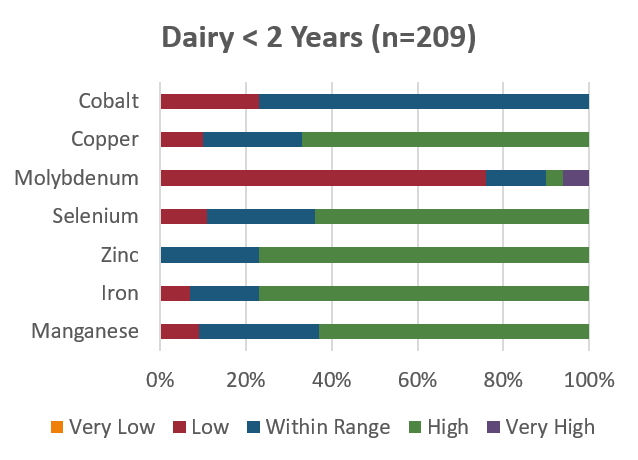
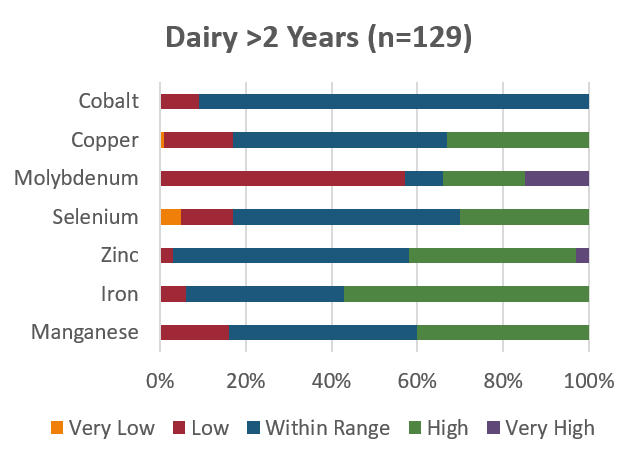
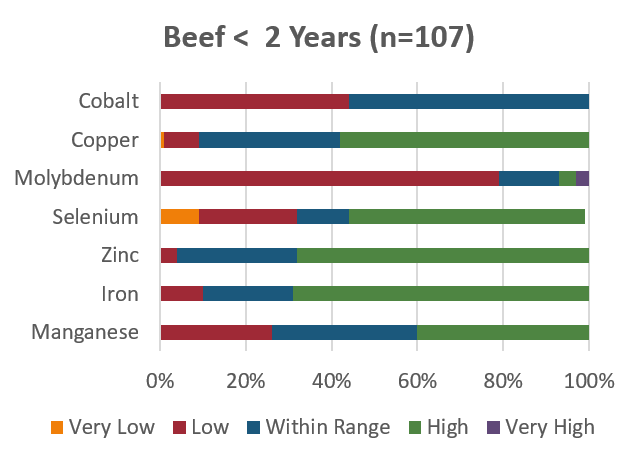
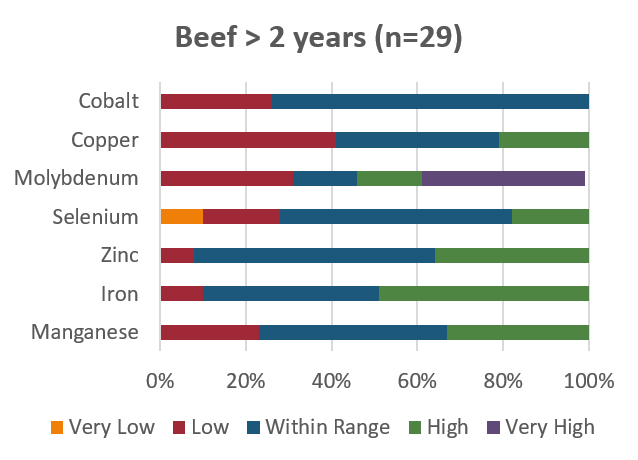
Cattle Reference Intervals:
- Cobalt: >0.1 ng/mL
- Copper: 0.6-1.0 ug/mL
- Molybdenum: 12-30 ng/mL
- Selenium: 0.08-0.15 ug/mL
- Zinc: 0.6-1.4 ug/mL
- Iron: 1.3-2.5 ug/mL
- Manganese: 1.5-2.5 ng/mL
HPAI in Dairy Cattle Update
Reported cases of HPAI in dairy cattle declined significantly during the summer and early fall of 2025. The USDA dashboard reports:
- June – 1 new case detected in California and 1 in Arizona
- July and August – single case each month detected in California
- September – 1 confirmed case in Texas and 1 in Nebraska
- October – 1 case in Idaho
The detection in Nebraska was the first in dairy cattle in the state. The Nebraska Department of Agriculture confirmed the herd has been quarantined and the genotype is B3.13, closely related to recent California strains. The case was linked to cows moved from a California herd enrolled in the state’s status program, which had previously met testing requirements. The cows tested positive in Nebraska after shipment, and illness followed. A subsequent bulk test in the California herd also returned positive.
Despite a decline in new cases, the California Department of Food and Agriculture confirmed on Aug 1 that 43 previously infected dairies have been re-quarantined by CDFA due to new detections of H5N1. These are new detections on dairies that were previously infected and met quarantine release criteria, 3 negative whole herd tests via bulk milk tank samples, one week apart. According to CDFA, these 43 farms have been shown to have sufficient virus present to be placed back under state quarantine.
Surveillance in Milk
USA See National Milk Testing Strategy | USDA
- As of Oct 22, 2025: 6 affected states, 33 states unaffected, 9 states provisionally unaffected
Canada – See Milk sampling and testing for highly pathogenic avian influenza (HPAI) in Canada – inspection.canada.ca
- As of Oct 22, 2025: 6,126 samples tested across Canada. All negative.
